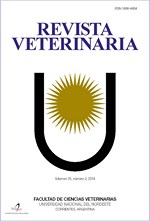Beta-lactam resistance in enterobacteria isolated from animal and water
DOI:
https://doi.org/10.30972/vet.251540Palabras clave:
domestic animals, enterobacteria, antibiotic resistance, β-lactamases.Resumen
The susceptibility to β-lactam antibiotics was analysed in thirty seven strains of enterobacteria from both animals and non-chlorinated water of rural areas from Corrientes, North-eastern Argentina. Twenty nine were isolated from animals: Klebsiella pneumoniae (n=9), Klebsiella oxytoca (n=1), Proteus mirabilis (n=7), Escherichia coli (n=12), and 8 from non-chlorinated water: E. coli (n=5), K. pneumoniae (n=2), K. oxytoca (n=1). The antibiograms were performed by the Kirby-Bauer technique using antibiotic discs of ampicillin, cefotaxime, cefepime, piperacillin and with β-lactamases inhibitors: clavulanic acid-amoxicillin, sulbactam- cefoperazone and tazobactam-piperacillin. Carbapenems with an EDTA disc as metallo β-lactamases inhibitor were also used. Neither phenotypically ESBL (extended-spectrum beta-lactamases) nor carbapenemase were detected. It can be inferred that the resistance observed in this assay may be attributed to a different source.Descargas
Descargas
Publicado
Cómo citar
Número
Sección
Licencia
Derechos de autor 2014 M. E. Cicuta, W. R. Roibón, M. C. Barceló, O. R. Arzú, V. I. Amable

Esta obra está bajo una licencia internacional Creative Commons Atribución-NoComercial 4.0.
Política de acceso abierto
Esta revista proporciona un acceso abierto inmediato a su contenido, basado en el principio de que ofrecer al público un acceso libre a las investigaciones ayuda a un mayor intercambio global de conocimiento. La publicación por parte de terceros será autorizada por Revista Veterinaria toda vez que se la reconozca debidamente y en forma explícita como lugar de publicación del original.
Esta obra está bajo una licencia de Creative Commons Reconocimiento-NoComercial 4.0 Internacional (CC BY-NC 4.0)










.jpg)
.jpg)



